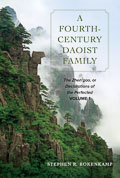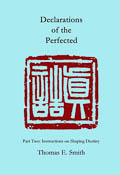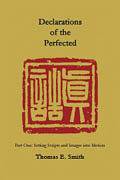start > Klassieke teksten > Late Han tot Tang > tekst
真誥 Zhengao
[Zhen’gao]
Engelse titel: Declarations of the Perfected
The Zhengao is a collection of Shangqing materials based on notes taken by Yang Xi and his patrons Xu Mai 許邁 (300–348) and Xu Mi 許謐 (303–76). Although it is a minor work compared to the Shangqing revealed writings, it has enjoyed greater fame due to the renown of its compiler, Tao Hong- jing, who completed it probably in 499.
The edition of the Zhengao in the Taoist Canon is divided into seven pian (sections) and twenty juan (scrolls), but this was not the original format.
The division into seven pian resulted from an effort, sometimes clumsy, made by Tao Hongjing to give coherence to the whole.
The first pian (corresponding to juan 1–4) contains texts that relate Yang Xi’s visions and hymns sung by the divinities on those occasions. The second and third pian (juan 5–8 and 9–10) are devoted to minor recipes and methods, with information on the afterlife of the Xus’ relatives and acquaintances in juan 7 and 8. The fourth pian (juan 11–14) contains a semimythical description and history of Mount Mao (Maoshan, Jiangsu), the early center of the Shangqing school. The fifth pian (juan 15–16) is devoted to a description of the netherworld. The sixth pian (juan 17–18) consists of writings from Yang Xi and the Xus. The seventh and last pian (juan 19–20) contains Tao’s own writings about his editorial method, the history of the Shangqing corpus of writings—especially how they were plagiarized and scattered—and the genealogy of the Xu family. This ideal sequence, however, is often disturbed by interpolations, repetitions, and insertion of fragments in wrong places. (Robinet in Pregadio 2008, p1258-59)
Indeling tekst
Onderstaande indeling is van Michel Strickmann geciteerd in Bokenkamp 2021.
Het boek bestaat uit zeven secties.
1. Minutes of the visionary sessions particularly relevant to Yang and the Xus. (chapters 1–4)
2. More general counsels and admonitions, often highly philosophical in tone, and documents related to the cause and treatment of disease. (chapters 5–8)
3. Technical instructions concerning a variety of technical operations, including propitiation of the stars and absorption of astral essence, respiration, and massage. (chapters 9–10)
4. Revelations concerning the secret subterranean structure and the administrative hierarchy of Mao Shan. (chapters 11–14)
5. Particulars concerning the isle of the dead, Fengdu, in the far north, and its spectral denizens. (chapters 15–16)
6. Personal jottings of Yang and the Xus—and thus, properly speaking, not “declarations” at all. Here are included specimens of their correspondence, extracts they made from secular as well as sacred writings, memoranda with regard to the performance of certain sacred duties, and records of their dreams. (chapters 17–18)
7.Nawoord van Tao Hongjing zelf (hst 19-20)
Literatuur en vertalingen
Hieronder kunt u een selectie maken van de verschillende publicatievormen en de taal. Ik beperk me tot vier taalgebieden (Nederlands, Engels, Frans en Duits). De meeste literatuur is overigens engelstalig. U kunt bij teksttype ook apart de vertalingen selecteren en U kunt desgewenst ook een specifieke auteur zoeken.
Boeken 1 tot 3 van de 3
Bokenkamp, Stephen R. (2021). A Fourth-Century Daoist Family: The Zhengao, or Declarations of the Perfected, Volume 1. University of California Press. *
Meer informatie...
Smith, Thomas (2020). Declarations of the Perfected, Part 2: Instructions on Shaping Destiny.
Meer informatie...
--- (2013). Declarations of the Perfected, Part 1: Setting Scripts and Images into Motion. Three Pine Press. *Meer informatie...
Boeken 1 tot 3 van de 3



